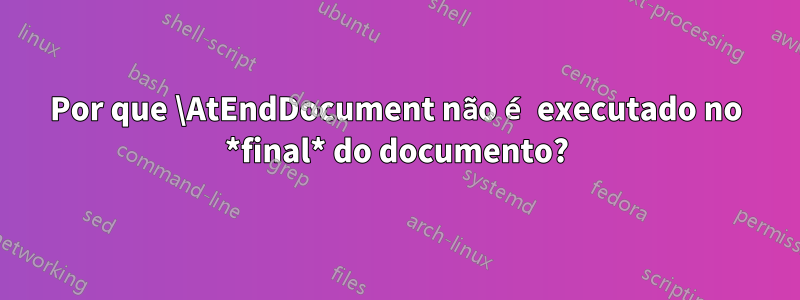
Devo estar fazendo algo incrivelmente estúpido, mas reduzi tudo ao máximo, sem sorte. Estou trabalhando em um bug que surgiu em um commit recente empagectrl @ca7dc3.
Eu tenho o seguinte exemplo mínimo:
\documentclass{minimal}
\AtEndDocument{\typeout{wat}}
\begin{document}
hello, world
\end{document}
com o seguinte registro
This is pdfTeX, Version 3.14159265-2.6-1.40.15 (TeX Live 2014) (preloaded format=pdflatex 2014.12.7) 9 DEC 2014 22:03
entering extended mode
restricted \write18 enabled.
%&-line parsing enabled.
**\input success-6.tex
(./success-6.tex (/usr/local/texlive/2014/texmf-dist/tex/latex/base/minimal.cls
Document Class: minimal 2001/05/25 Standard LaTeX minimal class
)
No file success-6.aux.
\openout1 = `success-6.aux'.
LaTeX Font Info: Checking defaults for OML/cmm/m/it on input line 5.
LaTeX Font Info: ... okay on input line 5.
LaTeX Font Info: Checking defaults for T1/cmr/m/n on input line 5.
LaTeX Font Info: ... okay on input line 5.
LaTeX Font Info: Checking defaults for OT1/cmr/m/n on input line 5.
LaTeX Font Info: ... okay on input line 5.
LaTeX Font Info: Checking defaults for OMS/cmsy/m/n on input line 5.
LaTeX Font Info: ... okay on input line 5.
LaTeX Font Info: Checking defaults for OMX/cmex/m/n on input line 5.
LaTeX Font Info: ... okay on input line 5.
LaTeX Font Info: Checking defaults for U/cmr/m/n on input line 5.
LaTeX Font Info: ... okay on input line 5.
wat
[1{/usr/local/texlive/2014/texmf-var/fonts/map/pdftex/updmap/pdftex.map}]
(./success-6.aux) )
Here is how much of TeX's memory you used:
17 strings out of 493109
369 string characters out of 6135004
52967 words of memory out of 5000000
3574 multiletter control sequences out of 15000+600000
3640 words of font info for 14 fonts, out of 8000000 for 9000
1141 hyphenation exceptions out of 8191
14i,4n,10p,120b,92s stack positions out of 5000i,500n,10000p,200000b,80000s
</usr/local/texlive/2014/texmf-dist/fonts/type1/public/amsfo
nts/cm/cmr10.pfb>
Output written on success-6.pdf (1 page, 11394 bytes).
PDF statistics:
12 PDF objects out of 1000 (max. 8388607)
7 compressed objects within 1 object stream
0 named destinations out of 1000 (max. 500000)
1 words of extra memory for PDF output out of 10000 (max. 10000000)
O que está me causando muita dor é esta parte do arquivo de log:
wat
[1{/usr/local/texlive/2014/texmf-var/fonts/map/pdftex/updmap/pdftex.map}]
Estou interpretando isso como significando que watestá sendo digitado antes mesmo de o documento começar ( [). O que estou fazendo de errado?
Responder1
O \AtEndDocumentgancho foi pensado principalmente para materiais a serem impressos no final de um documento, endereços ou notas, por exemplo.
O pacote atveryendfornece mais dois ganchos, com nomes autoexplicativos:
\documentclass{minimal}
\usepackage{atveryend}
\AtEndDocument{\typeout{atend}}
\AfterLastShipout{\typeout{afterlastshipout}}
\AtVeryEndDocument{\typeout{atveryend}}
\begin{document}
hello, world
\end{document}
Aqui está a saída no terminal:
This is pdfTeX, Version 3.14159265-2.6-1.40.15 (TeX Live 2014) (preloaded format=pdflatex)
restricted \write18 enabled.
entering extended mode
(./veryend.tex
LaTeX2e <2014/05/01>
Babel <3.9l> and hyphenation patterns for 79 languages loaded.
(/usr/local/texlive/2014/texmf-dist/tex/latex/base/minimal.cls
Document Class: minimal 2001/05/25 Standard LaTeX minimal class
) (/usr/local/texlive/2014/texmf-dist/tex/latex/oberdiek/atveryend.sty)
(./veryend.aux)
atend
[1{/usr/local/texlive/2014/texmf-var/fonts/map/pdftex/updmap/pdftex.map}]
afterlastshipout
(./veryend.aux)
atveryend
)</usr/local/texlive/2014/texmf-dist/fonts/type1/public/amsfonts/cm/cmr10.pfb>
Output written on veryend.pdf (1 page, 11397 bytes).
Transcript written on veryend.log.
Observe que atveryendestá digitadodepoiso .auxarquivo foi lido.
Responder2
\AtEndDocumentatualizações \@enddocumenthookdentro da \enddocumentmacro. O seguinte mostra sua localização em \enddocument(delatex.ltx):
\def\enddocument{%
\let\AtEndDocument\@firstofone
\@enddocumenthook% <---- Hook for \AtEndDocument
\@checkend{document}%
\clearpage% <---- Starts the final page builder
\begingroup
\if@filesw
\immediate\closeout\@mainaux
\let\@setckpt\@gobbletwo
\let\@newl@bel\@testdef
\@tempswafalse
\makeatletter \@@input\jobname.aux
\fi
\@dofilelist
\ifdim \font@submax >\fontsubfuzz\relax
\@font@warning{Size substitutions with differences\MessageBreak
up to \font@submax\space have occurred.\@gobbletwo}%
\fi
\@defaultsubs
\@refundefined
\if@filesw
\ifx \@multiplelabels \relax
\if@tempswa
\@latex@warning@no@line{Label(s) may have changed.
Rerun to get cross-references right}%
\fi
\else
\@multiplelabels
\fi
\fi
\endgroup
\deadcycles\z@\@@end}
Observe que \@enddocumenthooké executadoantes \clearpage, que inicia o construtor de páginas. Como tal, waté a saídaantesa construção da página começa. Para ter saídadepoiso \clearpage, você pode corrigir \enddocument(ou seguir algumas diretrizes emPosso conectar no final do documento, masdepoiso \clearpage?):
\documentclass{article}
\usepackage{etoolbox}
\patchcmd{\enddocument}% <cmd>
{\clearpage}% <search>
{\clearpage\typeout{wat}}% <replace>
{}{}% <success><failure>
\begin{document}
hello, world
\end{document}
Os .logrelatórios:
[1{/usr/local/texlive/2014/texmf-var/fonts/map/pdftex/updmap/pdftex.map}]
wat
Responder3
Você pode colocar suas macros no documento final \clearpagesem usar \patchcmdo etoolboxpacote. O primeiro método pode ser usado em casos muito simples:
\AtEndDocument{\clearpage\typeout{wat}}
Isso funciona porque o segundo \clearpage(dos internos do LaTeX) é processado quando a lista vertical principal inclui apenas itens descartáveis, ou seja, nenhuma página vazia é criada. Mas este método pode falhar quando outros pacotes são usados \AtEndDocumente supõem que suas macros serão processadas antes \clearpage. Então você pode usar um método mais robusto. Defina \afterclearpagea macro que muda seu argumento após \clearpagea sequência de controle interno:
\documentclass{article}
\def\afterclearpage#1#2\clearpage{#2\clearpage#1}
\AtEndDocument{\afterclearpage{\typeout{wat}}}
\begin{document}
hello, world
\end{document}


